Gigabyte Z77-HD4 Review
by Ian Cutress on May 19, 2013 10:00 AM EST- Posted in
- Motherboards
- Gigabyte
- Z77
Readers of our motherboard review section will have noted the trend in modern motherboards to implement a form of MultiCore Enhancement / Acceleration / Turbo (read our report here) on their motherboards. This does several things – better benchmark results at stock settings (not entirely needed if overclocking is an end-user goal), at the expense of heat and temperature, but also gives in essence an automatic overclock which may be against what the user wants. Our testing methodology is ‘out-of-the-box’, with the latest public BIOS installed and XMP enabled, and thus subject to the whims of this feature. It is ultimately up to the motherboard manufacturer to take this risk – and manufacturers taking risks in the setup is something they do on every product (think C-state settings, USB priority, DPC Latency / monitoring priority, memory subtimings at JEDEC). Processor speed change is part of that risk which is clearly visible, and ultimately if no overclocking is planned, some motherboards will affect how fast that shiny new processor goes and can be an important factor in the purchase.
For reference, the Gigabyte Z77-HD4 does enable MCT when XMP is enabled.
3D Movement Algorithm Test
The algorithms in 3DPM employ both uniform random number generation or normal distribution random number generation, and vary in various amounts of trigonometric operations, conditional statements, generation and rejection, fused operations, etc. The benchmark runs through six algorithms for a specified number of particles and steps, and calculates the speed of each algorithm, then sums them all for a final score. This is an example of a real world situation that a computational scientist may find themselves in, rather than a pure synthetic benchmark. The benchmark is also parallel between particles simulated, and we test the single thread performance as well as the multi-threaded performance.
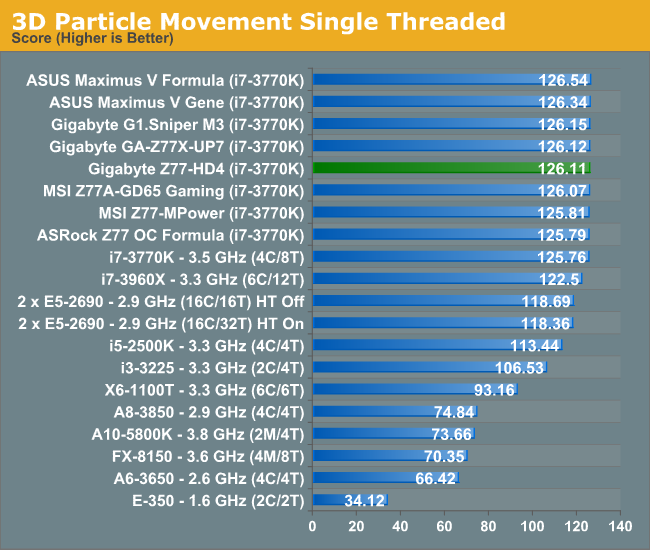
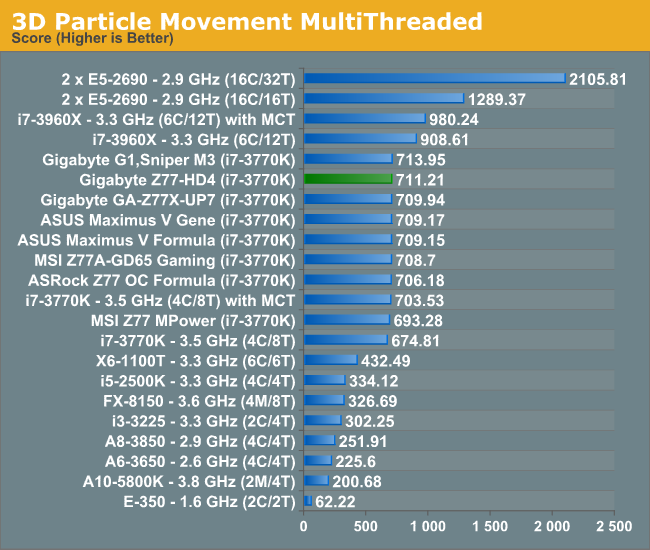
For a $120 motherboard, despite the DPC and Boot Time inefficiencies, the Z77-HD4 deals really well with our 3DPM benchmark, showcasing nice efficiency in multithreaded load. We do not test the memory here, so it provides a contrast result to the poor WinRAR performance below.
WinRAR x64 3.93 - link
With 64-bit WinRAR, we compress the set of files used in the USB speed tests. WinRAR x64 3.93 attempts to use multithreading when possible, and provides as a good test for when a system has variable threaded load. If a system has multiple speeds to invoke at different loading, the switching between those speeds will determine how well the system will do.
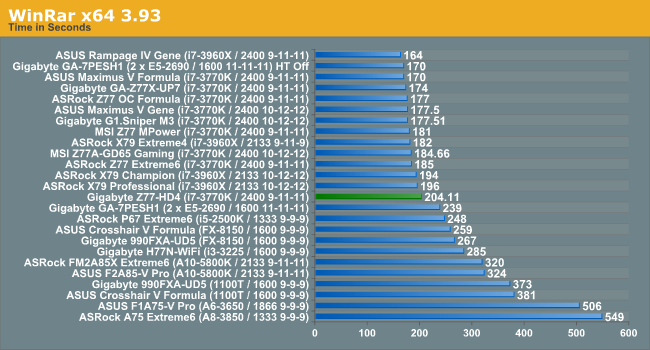
Despite the good 3DPM showing, the WinRAR score comes in as the worst 3770K+ at 2400 C9/C10 we have had. In contrast, for our new WinRAR 4.2 testing, the Z77-HD4 scored 54.36 seconds.
FastStone Image Viewer 4.2 - link
FastStone Image Viewer is a free piece of software I have been using for quite a few years now. It allows quick viewing of flat images, as well as resizing, changing color depth, adding simple text or simple filters. It also has a bulk image conversion tool, which we use here. The software currently operates only in single-thread mode, which should change in later versions of the software. For this test, we convert a series of 170 files, of various resolutions, dimensions and types (of a total size of 163MB), all to the .gif format of 640x480 dimensions.
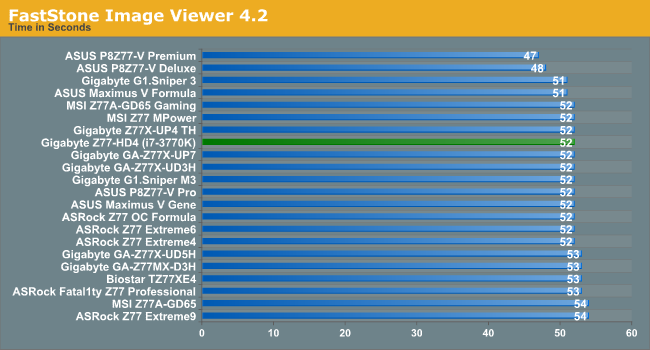
Xilisoft Video Converter
With XVC, users can convert any type of normal video to any compatible format for smartphones, tablets and other devices. By default, it uses all available threads on the system, and in the presence of appropriate graphics cards, can utilize CUDA for NVIDIA GPUs as well as AMD APP for AMD GPUs. For this test, we use a set of 32 HD videos, each lasting 30 seconds, and convert them from 1080p to an iPod H.264 video format using just the CPU. The time taken to convert these videos gives us our result.
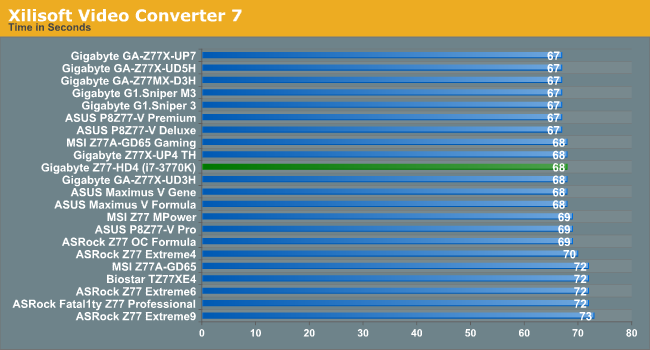
x264 HD Benchmark
The x264 HD Benchmark uses a common HD encoding tool to process an HD MPEG2 source at 1280x720 at 3963 Kbps. This test represents a standardized result which can be compared across other reviews, and is dependent on both CPU power and memory speed. The benchmark performs a 2-pass encode, and the results shown are the average of each pass performed four times.
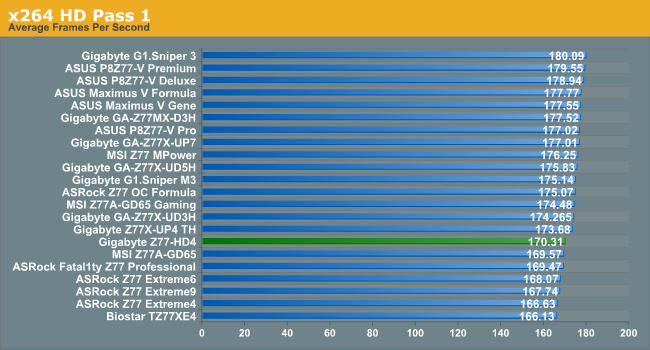
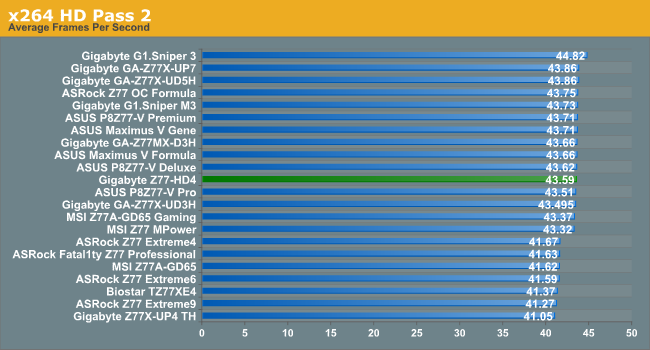










63 Comments
View All Comments
DanNeely - Monday, May 20, 2013 - link
Sata 6GB and USB3 both take significantly more die space on the chipset to implement; since most users only have at most a few devices that need the extra bandwidth most of ports offered on the chipset are still the older models. Haswell will probably be all Sata6GB on the chipset, although i wouldn't be surprised if some budget mobos add sata3gb ports via external controllers.The USB2/3 mix will probably last for a few more years on the desktop; this is both because of the much larger total number of ports involved, and because the internal headers aren't directly compatible (afaik you can buy adapters) and there're lots of cases which only have USB2 on the front panel; and lots of people with USB2 based cardreaders in a drive bay. I suspect one or two mobo headers for those will be with us for a long time; and wouldn't be surprised if a few linger as onboard/embedded device connects too like the pair of USB1 ports AMD chipsets still have (notionally for laptop keyboard/touchpad connects; but in both the desktop and mobile chipsets). I doubt the next generation of laptops will have any external USB2 ports; but might continue to use them internally.
maximumGPU - Monday, May 20, 2013 - link
haha those spam comments actually made me laugh.cjs150 - Monday, May 20, 2013 - link
This is a weird board.Full ATX but with 2x PCI slots. What do people use 1 for now, nevermind 2.
SATA sockets upright and in just the place that will ensure you lose the use of one of the SATA 6G sockets as soon as you put in a graphics card.
Spend a bit more a get a decent M-atx board with better layout
Wall Street - Monday, May 20, 2013 - link
Since the second x16 slot is powered from the x4 from the southbridge, I think they did this because they ran out of PCIe lanes. Also, some people use PCI for legacy devices. For example, I have a PCI TV tuner that I still use because a 4 year old tuner is just as good at HD as a new one.kasakka - Monday, May 20, 2013 - link
FireWire cards are actually still a good choice for using PCI slots, because most PCI-E FW cards cost 2x more and are essentially a PCI-to-PCI-E bridge chip + the PCI card's components. The few natively PCI-E FW cards are 3x more expensive than their PCI counterparts.Yes, FW still matters since most of the better audio interfaces use it so a big thing for studios or home recording, now that most motherboards don't come with a built-in FW chip.
It's the x4 full size PCI-E slots that make no sense to me.
DanNeely - Monday, May 20, 2013 - link
raid cards, or a second gpu for extra (non gaming) monitor outputs all need more than a single 1x lane; but 4 is plenty for anything they'd be asked to do. Some 4 port USB3 adapter cards on newegg are more than just 1x (though not explicitly marked I think they're 2x); presumably if you tried loading all 4 ports at once on the 1x cards you'd be bottlenecking on the PCIe bus.Wall Street - Monday, May 20, 2013 - link
You can install a PCIe x16 card in an x16 physical slot that is electrically PCIe x4. You also can install an PCIe x4 card in a x16 physical slot that is electrically x4. You cannot install a PCIe x16 card in a physical x4 slot. This is why they put an x16 physical slot for an x4 interface. An x16 physical slot is always at least as good.jabber - Monday, May 20, 2013 - link
X4 slots are hard to come by (I havent had a board with one fitted in years) so it may be they don't really make them anymore and just use a standard 16x slot instead.DanNeely - Monday, May 20, 2013 - link
I think the second PCI slot is as much about the limited number of PCIe lanes available as anything else. IIRC 7 series chipsets don't have native PCI support instead requiring a bridge chip, and only 8 PCIe lanes on the SB. That's 4 for the x4 slot, 2 for the 2x slots, 1 for the bridge, and 1 for the realtek nic (if I'm reading the specsheet right, the audio connects to the chipsets audio out and not over PCIe). That uses up all 8 available lanes; leaving the choice of only having 5 expansion slots filled, or spending more for a PCIe mux to add more available lanes. The latter is what I think many higher end boards do, but is cost-prohibitive in the value segment where every dollar counts.Cerb - Tuesday, May 21, 2013 - link
Awhile ago, I came across some audio books on cassette tape, and wanted to transfer them. My best input choice, by far, was an existing PCI sound card, with an external ADC. There you have it. For someone else, it may be an old but high quality plotter or scanner using SCSI, or a special serial card, or firewire card, or some other little thing.Like serial and parallel ports, PCI will be with us for awhile yet, though there is no good reason to need more than 1 of them, except that they would have had an unfilled slot, otherwise.
That 2nd slot is there, almost certainly, to fill space, due to using up the PCIe lanes available. Even MicroATX boards do this, giving 2 PCI slots, but an extra PCIe with more lanes, instead of several 1x PCIe slots.